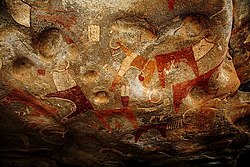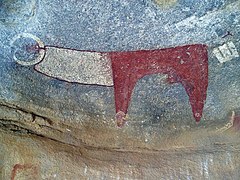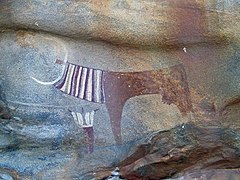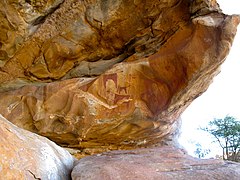Laas Geel
| Laas Geel | |
|---|---|
 | |
| Location | Hargeisa, Marodi Jeh, Somaliland |
| Coordinates | 9°46′51.28″N 44°26′37.11″E / 9.7809111°N 44.4436417°E |
| Discovery | 2002 |
| Access | Public |
Laas Geel (Somali: Laas Geel), also spelled Laas Gaal, are cave formations on the rural outskirts of Hargeisa, Somaliland, situated in the Maroodi Jeex region of the country. They contain some of the earliest known cave paintings of domesticated African aurochs (Bos primigenius africanus) in the Horn of Africa. Laas Geel's rock art is estimated to date to circa 3,500-2,500 BCE.[1][2][3][4][5][6]
Discovery

During November and December 2002, an archaeological survey was carried out in Somaliland by a French team of researchers. The expedition's objective was to search for rock shelters and caves that contained archaeological sediments and infills in order to document the historical period when production economy appeared in this part of the Horn of Africa (circa 5,000 to 2,000 years BCE). During the course of the survey, the excavation team discovered the Laas Geel cave paintings, that encompass an area of ten rock alcoves (caves).[7] In an excellent state of preservation, the rock art depicts wild animals and decorated cattle (cows and bulls). They also feature herders, who are believed to be the creators of the paintings.[8] Laas Geel's rock art is executed in the same distinctive Ethiopian-Arabian style as the Dhambalin and Karinhegane cave paintings that are also situated in Somaliland.[9]
Although the Laas Geel rock art had been known to the area's inhabitants for centuries, its existence only came to international attention after the 2002 discovery. In November 2003, a mission returned to Laas Geel and a team of experts undertook a detailed study of the paintings in their prehistoric context.

Description
The Laas Geel cave paintings are thought to be some of the most vivid rock art in
Gallery
-
Depiction of a ceremonial cow
-
A human and cow
-
A herd of cows
-
A single cow
-
One of the alcoves at Laas Geel
-
Various rock art
-
Various other rock art
-
A camel
The word laas geel consist of two words according to Somali languages which is laas and geel, the word laas means well and the word geel means camel in Somali. Well refers to a source of water which camels and other livestock drink from as well as the people.
See also
References
- ^ "Laas Geel, Somaliland". British Museum.
Unlike many other rock art sites, Laas Geel has been dated quite precisely thanks to the excavations carried out in one of the shelters by the French team that documented the site. During the excavation parts of the painted rock wall were recovered, and therefore the archaeologists have proposed a chronology of mid-4th to mid-3rd millennia, being one of the oldest evidences of cattle domestication in the Horn of Africa and the oldest known rock art site in this region.
- ISBN 978-1-7936-0643-3.
- PMID 8643540.
- PMID 30622640.
- PMID 26104394.
- ISSN 1573-7802.
- ^ a b The Journal of African Archeology Volume 1.2 (2003) Chapter 3
- ^ Bakano, Otto (April 24, 2011). "Grotto galleries show early Somali life". AFP. Archived from the original on 30 April 2011. Retrieved 11 May 2013.
- ^ Istituto universitario orientale (Naples, Italy) (1992). Annali: Supplemento, Issues 70-73. Istituto orientale di Napoli. p. 57.
- ISSN 0263-0338.
- ^ Michael Hodd, East African Handbook, (Trade & Travel Publications: 1994), p.640.
- ^ "Photographs of Laas Geel, February 2015". Independent Travellers. independent-travellers.com. Retrieved July 15, 2017.










